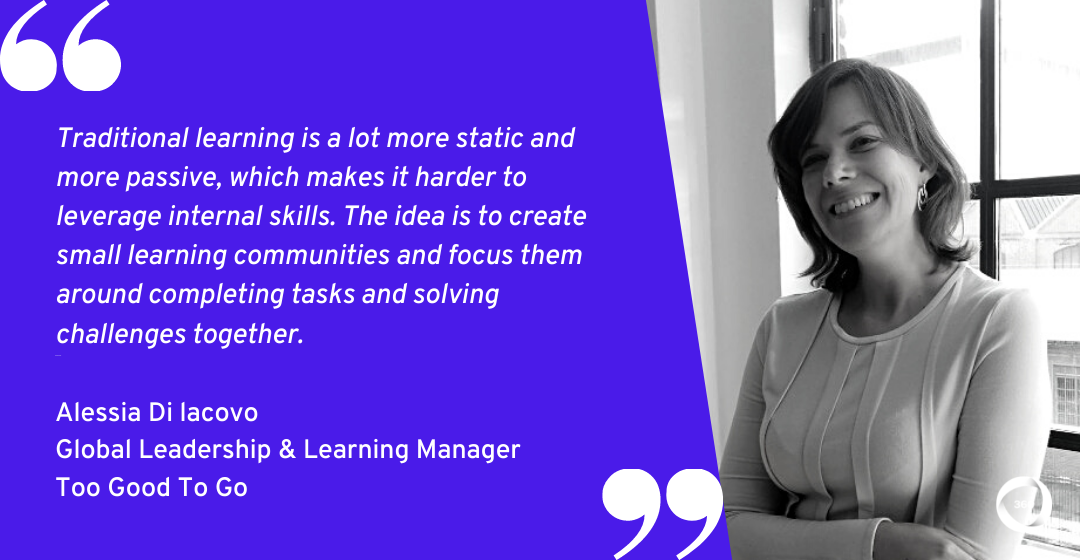These days, there’s no such thing as a linear career progression. There are more opportunities than ever for people to take on new challenges and develop a real mixture of skills and capabilities as they grow.
This is especially the case for key account managers, who play a strategic role in company growth by supporting high-value accounts and ensuring a consistent standard of customer care. So, how should L&D leaders structure growth paths to support key account managers?
I sat down with Alessia Di lacovo, Global Leadership & Learning Manager at food tech company Too Good To Go, to discuss exactly that. Alessia told me about their unique people and culture challenges as a fast-growing startup, her three-step approach to piloting a new growth path for key account managers, and how she uses Collaborative Learning to create new opportunities for people to take the next big step.
We kicked things off by discussing Too Good To Go’s impressive growth story.
Too Good To Go: from startup to 1,000+ employees in just 4 years
As Alessia explains, Too Good To Go has experienced a rapid expansion recently, going from startup to global organization in just a few short years.
“Too Good To Go is a food tech company, and a global leader in the fight against food waste,” she says. “Our core business isn’t just about approaching the problem of food waste from a technological perspective–it’s about promoting a cultural change in our consumption habits.”
“We started as a Denmark-based startup around four years ago, and we’re now present in 16 countries between the European Union and North America. Just last week, we passed the threshold of 1,000 employees. It’s a massive growth rate for just four years.”
As with every organization experiencing such a fast rate of growth, Too Good To Go’s culture has played a key role in keeping things on track. So, how does Too Good To Go ensure the right focus on its distinctive values around the world?
“From a People & Culture perspective, we have a global team, which I’m part of,” says Alessia. “Each country then has local People & Culture managers, and they’re the ones we collaborate with to drive our specific learning and development projects and initiatives.”
Related: Better.com's Onboarding Process for Growing From 350 to 3,000 Employees
Our core business isn’t just about approaching the problem of food waste from a technological perspective–it’s about promoting a cultural change in our consumption habits.
You can never have enough expert insights! Check out our ebook to find out How L&D Can Help You Build a Strong Company Culture
Global vs. local: the big challenge for People & Culture
Food waste is a truly global problem, with a third of the world’s food being thrown out. To make a difference, Too Good To Go needs to have a global presence, as well as focusing on specific markets. As Alessia explains, this creates some challenges for People & Culture.
1. Attracting the right talent and keeping people motivated
“One of the first challenges is definitely keeping our pipeline of talent alive so that we can keep up our pace of growth around the world,” she says. “So far we’ve addressed that very well.”
Once people come on board, there’s a whole new set of challenges. “We also need to provide the right opportunities for people to grow within the company once they’ve joined us. This means showcasing the different opportunities that come with such a fast pace of growth.”
“It takes strong communication, and a commitment to raising awareness in terms of how people fit in with their skills and growth aspirations. We’re also defining how we want to work with our talent–that’s another big conversation for us.”
2. Shifting perceptions around career progression
For Alessia and her team, balancing this global and local focus is also about changing perceptions around what career progression should look like.
“We’re trying to define progression as not necessarily being only a question of vertical promotion,” she says. “We also want to grow our subject-matter experts, whether that’s through coaching others, or focusing more on horizontal growth. We want to bridge the gap from who we are now to who we want to be in the future.”
3. Navigating different backgrounds and market maturities
“Another big challenge is the fact that our people bring a range of different backgrounds,” says Alessia. “We have some people coming from the startup background, and others coming from a corporate environment. They can have very different cultures.”
“Our markets and countries also have different maturity levels. You can’t compare our United States office, which opened in 2020 and is now approaching 200 employees, with a more consolidated and smaller market like Denmark, Sweden, or the Netherlands.”
So, how does Alessia respond to these challenges? “We’re a global company, and that’s a big advantage that we have. It’s about finding the balance between providing global consistency and allowing local flexibility. We want people to experiment with things in their own way, and we need to be quick in responding to their needs. These challenges are why I joined the company.”
It’s about finding the balance between providing global consistency and allowing local flexibility. We want people to experiment with things in their own way, and we need to be quick in responding to their needs. These challenges are why I joined the company.
3 steps to piloting a new growth path for key account managers
With Too Good To Go expanding so quickly, Alessia knew she needed to offer tailored support for strategic roles, such as key account managers. That’s why she’s piloting a new growth path for key account managers using a three-step approach based in Collaborative Learning.
The first step? Get the right stakeholders on board.
1. Aligning with key stakeholders
“One big part of addressing these challenges is about making the time and energy to constantly align with different stakeholders and seek their input,” says Alessia.
“This is a project led by People & Culture, but a lot of our input comes from elsewhere in the business. We’re moving away from the idea of just creating beautiful content, and looking for ways to make everything more relevant and useful for people in their particular roles.”
2. Leveraging peer learning and internal expertise
“We’re also looking for new ways to leverage peer learning and internal expertise, because this is one of the key foundations for our growth path.”
“We start by profiling our participants and creating smaller learning sub-groups where people can mentor each other and benefit from cross-country exchange–especially from our more mature markets. We want our key account managers to learn what their colleagues are doing, share their best practices, and really leverage their internal skills and talents.”
As Alessia explains, this approach offers some big advantages over other forms of learning. “Traditional learning is a lot more static and more passive, which makes it harder to leverage internal skills. The idea is to create small learning communities and focus them around completing tasks and solving challenges together.”

“We want these communities to focus as closely as possible on the actual challenges people will face within the business, and keep the connection between what happens within these learning moments, and what they need in real life. We want to bridge that gap as much as possible.”
3. Using external training to offer a fresh perspective
As helpful as this internal expertise is, says Alessia, it’s important to mix in some external training too.
“We’re using a mixture of external training, because I like the idea of bringing in fresh perspectives to match the areas where we may not be quite as developed,” she says. “At the same time, there’s a wealth of talent and resources, and we just need the right support to bring that to the surface and share it in a scalable way.”
Right now this pilot growth path focuses just on key account managers, but the long-term goal is to go further. “We’re working with approximately 100 key account managers, but if this first pilot works, there are many other roles within the company we could extend it to.”
“We have a lot of other growth paths, including within our sales team, our customer success team, and marketing. There’s a lot of potential for us to expand on this pilot.”
Related: What is Collaborative Learning Theory and Why Do You Need It?
Measuring the impact of Too Good To Go’s pilot growth path
Because the key account manager pilot growth path is still so new, Alessia and her team are focusing closely on measuring their impact.
“The pilot has only just been announced, and our real kickoff will be in June,” says Alessia. “We haven’t officially started all of our learning activities yet. But part of our profiling also involves checking in on people’s expectations and their levels of commitment and motivation.”
“While it is a global program, it’s also crucial for people to feel like it’s relevant for them, and not just something that we’re prescribing in a top-down way.”
Fortunately, says Alessia, the initial feedback is very positive. “The first feedback that we’re starting to collect suggests a very high level of motivation for people, and lots of interest in the possibility to learn alongside colleagues. People are eager to be part of a learning experience that mixes learning moments and real-life challenges as much as possible.”
People are eager to be part of a learning experience that mixes learning moments and real-life challenges as much as possible.
So, what specific metrics will Alessia be focusing on? “I’m aiming for a great NPS,” she says. “We want to offer the kind of global training that people would actively choose, even if they had another option. We also want to measure outcomes against the individual learning goals people set for themselves at the beginning. This way, we can identify what worked, and what didn’t.”
“We’ve received a lot of positive feedback around the new key account growth path, and it’s been great to see all that enthusiasm. It also means there’s a lot of pressure, but it’s really motivating. I’m really looking forward to delivering based on those expectations.”
Related: 3 Data-Based Ways to Provide Training ROI (+ Free Training ROI Calculator)
Thanks again to Alessia for sharing her story!
While you’re here, check out my expert interviews with Natalie Higgins of Klaviyo about how to achieve new hire enablement NPS results of over 85% with Collaborative Learning, and with Joe Wilmoth of Dermira about keeping employee engagement high during COVID-19.
Want more peer insights on transforming workplace learning? Check out #CLOConnect, our interview series with top L&D leaders on driving growth and scaling culture through Collaborative Learning. Or you can subscribe (below 👇) to our weekly newsletter to receive our latest posts directly in your inbox.



